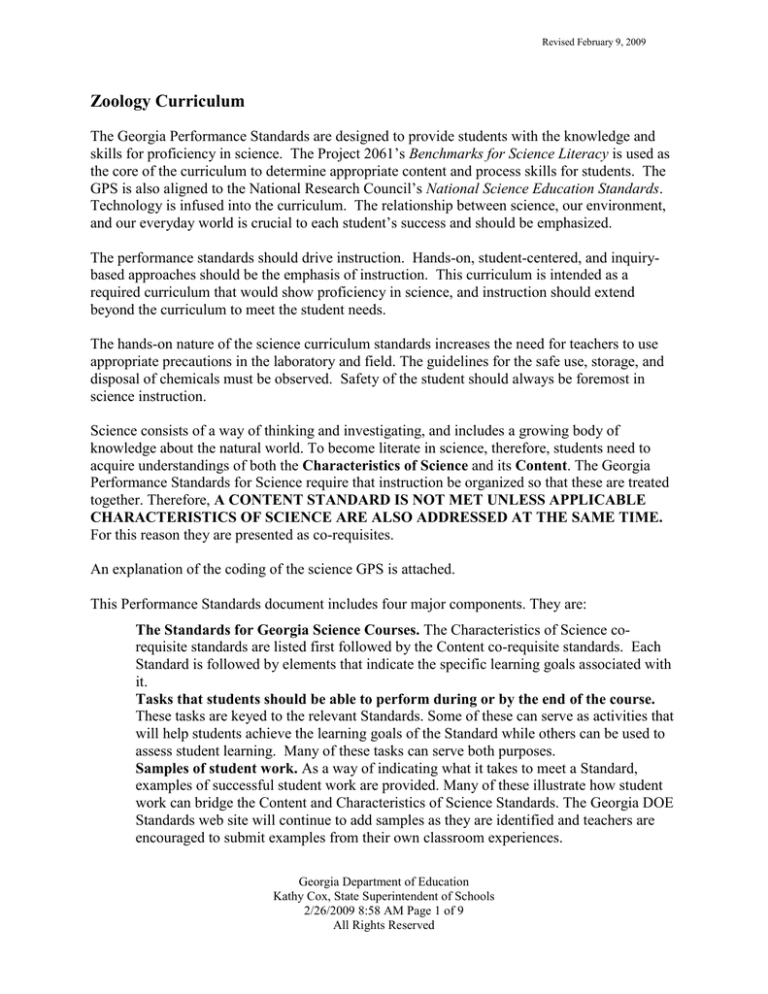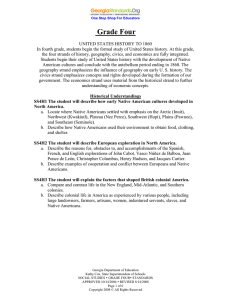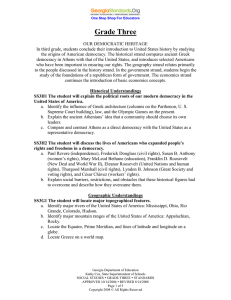
Revised February 9, 2009
Zoology Curriculum
The Georgia Performance Standards are designed to provide students with the knowledge and
skills for proficiency in science. The Project 2061’s Benchmarks for Science Literacy is used as
the core of the curriculum to determine appropriate content and process skills for students. The
GPS is also aligned to the National Research Council’s National Science Education Standards.
Technology is infused into the curriculum. The relationship between science, our environment,
and our everyday world is crucial to each student’s success and should be emphasized.
The performance standards should drive instruction. Hands-on, student-centered, and inquirybased approaches should be the emphasis of instruction. This curriculum is intended as a
required curriculum that would show proficiency in science, and instruction should extend
beyond the curriculum to meet the student needs.
The hands-on nature of the science curriculum standards increases the need for teachers to use
appropriate precautions in the laboratory and field. The guidelines for the safe use, storage, and
disposal of chemicals must be observed. Safety of the student should always be foremost in
science instruction.
Science consists of a way of thinking and investigating, and includes a growing body of
knowledge about the natural world. To become literate in science, therefore, students need to
acquire understandings of both the Characteristics of Science and its Content. The Georgia
Performance Standards for Science require that instruction be organized so that these are treated
together. Therefore, A CONTENT STANDARD IS NOT MET UNLESS APPLICABLE
CHARACTERISTICS OF SCIENCE ARE ALSO ADDRESSED AT THE SAME TIME.
For this reason they are presented as co-requisites.
An explanation of the coding of the science GPS is attached.
This Performance Standards document includes four major components. They are:
The Standards for Georgia Science Courses. The Characteristics of Science corequisite standards are listed first followed by the Content co-requisite standards. Each
Standard is followed by elements that indicate the specific learning goals associated with
it.
Tasks that students should be able to perform during or by the end of the course.
These tasks are keyed to the relevant Standards. Some of these can serve as activities that
will help students achieve the learning goals of the Standard while others can be used to
assess student learning. Many of these tasks can serve both purposes.
Samples of student work. As a way of indicating what it takes to meet a Standard,
examples of successful student work are provided. Many of these illustrate how student
work can bridge the Content and Characteristics of Science Standards. The Georgia DOE
Standards web site will continue to add samples as they are identified and teachers are
encouraged to submit examples from their own classroom experiences.
Georgia Department of Education
Kathy Cox, State Superintendent of Schools
2/26/2009 8:58 AM Page 1 of 9
All Rights Reserved
Revised February 9, 2009
Teacher Commentary. Teacher commentary is meant to open the pathways of
communication between students and the classroom teacher. Showing students why they
did or did not meet a standard enables them to take ownership of their own learning.
Georgia Department of Education
Kathy Cox, State Superintendent of Schools
2/26/2009 8:58 AM Page 2 of 9
All Rights Reserved
Revised February 9, 2009
Georgia Performance Science Standards-- Explanation of Coding
Characteristics of Science Standards
SKCS1
Science Kindergarten Characteristics of Science Standard #1
S8CS2
Science Grade 8 Characteristics of Science Standard #2
SCSh8
Science Characteristics of Science high school Standard #8
Content Standards
S5P3
Science Grade 5 Physical Science Standard #3
S4E2
Science Grade 4 Earth Science Standard #2
S7L4
Science Grade 7 Life Science Standard #4
SC1
Science Chemistry Standard #1
SB4
Science Biology Standard #4
SPS6
Science Physical Science Standard #6
SP3
Science Physics Standard #3
SAST2
Science ASTronomy Standard #2
SEC1
Science ECology Standard #1
SFS3
Science Forensic Science Standard #3
SZ1
Science Zoology Standard #1
Georgia Department of Education
Kathy Cox, State Superintendent of Schools
2/26/2009 8:58 AM Page 3 of 9
All Rights Reserved
Revised February 9, 2009
Zoology
Modern zoology is the study of all things dealing with animals. As the science has advanced
over the decades, modern zoologists study more than just recognition and classification of
animals; their attention now includes animal anatomy, physiology, development, histology,
ecology, behavior, and evolution. The ‘story’ of animals is told through evolutionary patterns
across deep spans of time. Thus, the focus of this course is the recognition of key features of the
major body plans that have evolved in animals and how those body plans have changed over
time resulting in the diversity of animals that are evident today.
In addition to classification and recognition, this course teaches students about the anatomical
and physiological characteristics of animals. These characteristics relate to how an animal
functions and can help students see the connections uniting particular animal groups. An
understanding of form and function allows students to study how animals have evolved over time
and to relate animals to their particular role in an ecosystem.
Finally, students will develop an understanding that all living things are interconnected. It is the
responsibility of humans to ensure that animal populations are managed to preserve species.
Students should realize that the worldwide activities of humans can contribute to animal
diversity both positively and negatively. It should also be understood that humans are dependent
on animal species for advances in medicine, ecosystem maintenance, and food supply.
Co-Requisite – Characteristics of Science
Habits of Mind
SCSh1.
Students will evaluate the importance of curiosity, honesty, openness, and
skepticism in science.
a. Exhibit the above traits in their own scientific activities.
b. Recognize that different explanations often can be given for the same evidence.
c. Explain that further understanding of scientific problems relies on the design and
execution of new experiments which may reinforce or weaken opposing
explanations.
SCSh2.
Students will use standard safety practices for all classroom laboratory and field
investigations.
a. Follow correct procedures for use of scientific apparatus.
b. Demonstrate appropriate technique in all laboratory situations.
c. Follow correct protocol for identifying and reporting safety problems and
violations.
SCSh3.
Students will identify and investigate problems scientifically.
a. Suggest reasonable hypotheses for identified problems.
b. Develop procedures for solving scientific problems.
c. Collect, organize and record appropriate data.
d. Graphically compare and analyze data points and/or summary statistics.
Georgia Department of Education
Kathy Cox, State Superintendent of Schools
2/26/2009 8:58 AM Page 4 of 9
All Rights Reserved
Revised February 9, 2009
e. Develop reasonable conclusions based on data collected.
f. Evaluate whether conclusions are reasonable by reviewing the process and
checking against other available information.
SCSh4.
Students use tools and instruments for observing, measuring, and manipulating
scientific equipment and materials.
a. Develop and use systematic procedures for recording and organizing information.
b. Use technology to produce tables and graphs.
c. Use technology to develop, test, and revise experimental or mathematical models.
SCSh5.
Students will demonstrate the computation and estimation skills necessary for
analyzing data and developing reasonable scientific explanations.
a. Trace the source on any large disparity between estimated and calculated answers
to problems.
b. Consider possible effects of measurement errors on calculations.
c. Recognize the relationship between accuracy and precision.
d. Express appropriate numbers of significant figures for calculated data, using
scientific notation where appropriate.
e. Solve scientific problems by substituting quantitative values, using dimensional
analysis and/or simple algebraic formulas as appropriate.
SCSh6.
Students will communicate scientific investigations and information clearly.
a. Write clear, coherent laboratory reports related to scientific investigations.
b. Write clear, coherent accounts of current scientific issues, including possible
alternative interpretations of the data.
c. Use data as evidence to support scientific arguments and claims in written or oral
presentations.
d. Participate in group discussions of scientific investigation and current scientific
issues.
The Nature of Science
SCSh7.
Students analyze how scientific knowledge is developed.
Students recognize that:
a. The universe is a vast single system in which the basic principles are the same
everywhere.
b. Universal principles are discovered through observation and experimental
verification.
c. From time to time, major shifts occur in the scientific view of how the world
works. More often, however, the changes that take place in the body of scientific
knowledge are small modifications of prior knowledge. Major shifts in scientific
views typically occur after the observation of a new phenomenon or an insightful
interpretation of existing data by an individual or research group.
d. Hypotheses often cause scientists to develop new experiments that produce
additional data.
Georgia Department of Education
Kathy Cox, State Superintendent of Schools
2/26/2009 8:58 AM Page 5 of 9
All Rights Reserved
Revised February 9, 2009
e. Testing, revising, and occasionally rejecting new and old theories never ends.
SCSh8.
Students will understand important features of the process of scientific inquiry.
Students will apply the following to inquiry learning practices:
a. Scientific investigators control the conditions of their experiments in order to
produce valuable data.
b. Scientific researchers are expected to critically assess the quality of data including
possible sources of bias in their investigations’ hypotheses, observations, data
analyses, and interpretations.
c. Scientists use practices such as peer review and publication to reinforce the
integrity of scientific activity and reporting.
d. The merit of a new theory is judged by how well scientific data are explained by
the new theory.
e. The ultimate goal of science is to develop an understanding of the natural
universe which is free of biases.
f. Science disciplines and traditions differ from one another in what is studied,
techniques used, and outcomes sought.
Georgia Department of Education
Kathy Cox, State Superintendent of Schools
2/26/2009 8:58 AM Page 6 of 9
All Rights Reserved
Revised February 9, 2009
Reading Standard Comment
After the elementary years, students are seriously engaged in reading for learning. This process
sweeps across all disciplinary domains, extending even to the area of personal learning. Students
encounter a variety of informational as well as fictional texts, and they experience text in all
genres and modes of discourse. In the study of various disciplines of learning (language arts,
mathematics, science, social studies), students must learn through reading the communities of
discourse of each of those disciplines. Each subject has its own specific vocabulary, and for
students to excel in all subjects, they must learn the specific vocabulary of those subject areas in
context.
Beginning with the middle grades years, students begin to self-select reading materials based on
personal interests established through classroom learning. Students become curious about
science, mathematics, history, and literature as they form contexts for those subjects related to
their personal and classroom experiences. As students explore academic areas through reading,
they develop favorite subjects and become confident in their verbal discourse about those
subjects.
Reading across curriculum content develops both academic and personal interests in students.
As students read, they develop both content and contextual vocabulary. They also build good
habits for reading, researching, and learning. The Reading Across the Curriculum standard
focuses on the academic and personal skills students acquire as they read in all areas of learning.
SCSh9. Students will enhance reading in all curriculum areas by:
a. Reading in all curriculum areas
Read a minimum of 25 grade-level appropriate books per year from a variety
of subject disciplines and participate in discussions related to curricular
learning in all areas.
Read both informational and fictional texts in a variety of genres and modes
of discourse.
Read technical texts related to various subject areas.
b. Discussing books
Discuss messages and themes from books in all subject areas.
Respond to a variety of texts in multiple modes of discourse.
Relate messages and themes from one subject area to messages and themes in
another area.
Evaluate the merit of texts in every subject discipline.
Examine author’s purpose in writing.
Recognize the features of disciplinary texts.
c. Building vocabulary knowledge
Demonstrate an understanding of contextual vocabulary in various subjects.
Use content vocabulary in writing and speaking.
Explore understanding of new words found in subject area texts.
d. Establishing context
Georgia Department of Education
Kathy Cox, State Superintendent of Schools
2/26/2009 8:58 AM Page 7 of 9
All Rights Reserved
Revised February 9, 2009
Explore life experiences related to subject area content.
Discuss in both writing and speaking how certain words are subject area
related.
Determine strategies for finding content and contextual meaning for unknown
words.
Co-Requisite – Content
SZ1.
Students will derive the phylogeny of animal taxa (monophyletic clades in a
cladogram) using informative characteristics.
a. Construct a classification of representative animal taxa including: Porifera,
Cnidaria, Platyhelminthes, Nematoda, Annelida, Rotifera, Mollusca, Arthropoda
(Mandibulata, Chelicerata, and Crustacea), Bryozoa, Brachiopoda,
Echinodermata, Hemichordata, Urochordata, Cephalochordata, and Vertebrata.
b. Place taxa in a phylogenetic (evolutionary) context and provide data to support
hypotheses of relationships
Construct a graphical representation of animal evolution (cladogram)
Recognize characters that are shared and derived, uniting taxa
Interpret graphical representations of animal evolution (cladograms)
d. Recognize types of data used to test hypotheses of relationships.
SZ2.
Students will explain the evolutionary history of animals over the geological
history of Earth.
a. Outline the geological history of Earth and discuss the major environmental
changes that have occurred over time.
b. Explain the concepts evolution, adaptation, natural selection, convergence, and
speciation.
c. Describe the fossil record of the animals including discussing the Cambrian
Explosion and major extinction events.
SZ3.
Students will compare form and function relationships within animal groups
(clades) and across key taxa.
a. Explain the similarities and differences among major body plans (e.g.,
asymmetry, radial and bilateral symmetry).
b. Compare and contrast taxa based on morphological and genetic characters.
c. Relate important structural changes to key functional transitions.
d. Dissect representative taxa and describe their internal anatomy and the function of
major organ systems and organs and relate to cell specializations.
Georgia Department of Education
Kathy Cox, State Superintendent of Schools
2/26/2009 8:58 AM Page 8 of 9
All Rights Reserved
Revised February 9, 2009
SZ4.
Students will assess how animals interact with their environment including key
adaptations found within animal taxa.
a. Discuss morphological and physiological adaptations relative to ecological roles.
b. Relate animal adaptations, including behaviors, to the ecological roles of animals.
c. Explain various life cycles found among animals (e.g., polyp and medusa in
cnidarians; multiple hosts and stages in the platyhelminthe life cycle; arthropod
metamorphosis; egg, tadpole, adult stages in the amphibian life cycle).
SZ5.
Students will evaluate the relationships between humans and other animals.
a. Describe the effects of human activities such as habitat destruction, over hunting,
introduced species, and pollution on animal biodiversity.
b. Explain the importance of species diversity to the biological resources needed by
human populations including food, medicine, and natural aesthetics
c. Compare and contrast how humans can preserve animal diversity in captive and
natural environments with regard to habitat creation and conservation, research,
legislation, animal enrichment, diet, medical, breeding programs and management
of genetic diversity at local and global levels.
d. Investigate how moral, legal, societal, political, and economic decisions impact
animal diversity with short-term and long-term effects.
Georgia Department of Education
Kathy Cox, State Superintendent of Schools
2/26/2009 8:58 AM Page 9 of 9
All Rights Reserved








